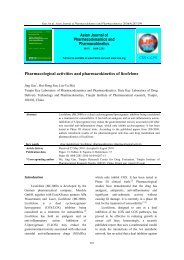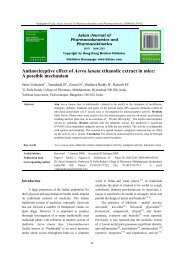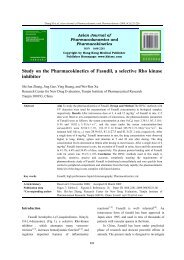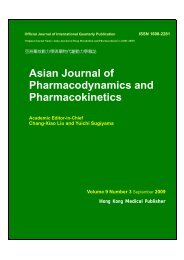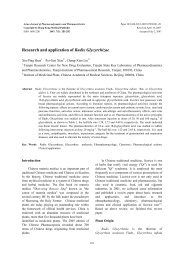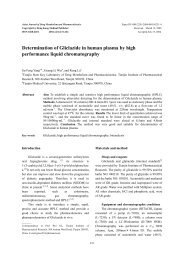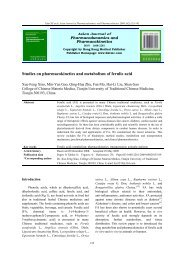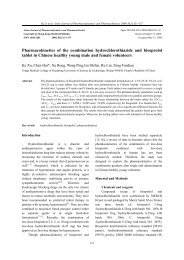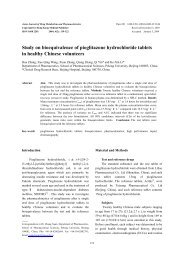Asian Journal of Pharmacodynamics and Pharmacokinetics ...
Asian Journal of Pharmacodynamics and Pharmacokinetics ...
Asian Journal of Pharmacodynamics and Pharmacokinetics ...
- No tags were found...
You also want an ePaper? Increase the reach of your titles
YUMPU automatically turns print PDFs into web optimized ePapers that Google loves.
Liu CX. <strong>Asian</strong> <strong>Journal</strong> <strong>of</strong> <strong>Pharmacodynamics</strong> <strong>and</strong> <strong>Pharmacokinetics</strong> 2010; 10(4):247-260<strong>Asian</strong> <strong>Journal</strong> <strong>of</strong><strong>Pharmacodynamics</strong> <strong>and</strong><strong>Pharmacokinetics</strong>ISSN 1608-2281Full text is available at www.hktcm.com <strong>and</strong> www.issx.orgCSSX-CPSTranslational research in drug discovery, research <strong>and</strong> developmentChang-Xiao LiuState Key Laboratory <strong>of</strong> Drug Delivery Technology <strong>and</strong> <strong>Pharmacokinetics</strong>, Tianjin Institute <strong>of</strong>Pharmaceutical Research, Tianjin 300193, ChinaAbstractIn this review, according to limited information, author focuses application <strong>of</strong>translational research to drug discovery <strong>and</strong> development. Translational research is theunderlying basis for Translational Medicine 'the process which leads from evidence basedmedicine to sustainable solutions for public health problems. Scientists <strong>and</strong> scholars whoare able to focus their efforts to link basic scientific discoveries with the arena <strong>of</strong> clinicalinvestigation, <strong>and</strong> translating the results <strong>of</strong> clinical trials into changes in clinical practice,informed by evidence from the social <strong>and</strong> political sciences. For drug discovery <strong>and</strong>development, translational research can be divided into three phases. Phase oneTranslational Research is the research process that explores needs, develops potentialtreatments in basic laboratory research, <strong>and</strong> tests safety <strong>and</strong> efficacy, principally inr<strong>and</strong>omized clinical trials. Phase two Translational Research examines how findings fromclinical science, shown to be efficacious <strong>and</strong> safe treatments established in phase onetranslational research, function when they are applied in routine practice. Phase threeTranslational Research adds the necessary information to convert treatments <strong>and</strong>prevention strategies, shown to be effective <strong>and</strong> cost-effective in Phase two TranslationalResearch, into sustainable solutions. Current innovative drug research <strong>and</strong> development<strong>of</strong> the theory, methods, <strong>and</strong> key technology are the rapid emergence in China. To improvethe strength <strong>and</strong> the overall level, the establishment <strong>of</strong> China's independent innovationsystem is very important. Therefore, we face major challenges in innovative drug researchin China to reach close to the country's overall level to improve the drug innovation.Key words Biomarker; bioinformatics, discovery; development; drug; pharmacodynamics;pharmacokinetics; target;; translational medicine; translational researchArticle history Received August 15, 2010; Accepted October 30, 2010Publication data Pages: 7; Tables: 3; Figures:7; References: 34; Paper ID: AJPP-16082281-2010-04-247-14*Corresponding author Corresponding author Pr<strong>of</strong>essor Chang-Xiao Liu, Research Center for New DrugEvaluation, Tianjin Institute <strong>of</strong> Pharmaceutical Research, Tianjin 300193, China. E-mail:liuchangxiao@vip163.comIntroductionIn 1978, Abernathy <strong>and</strong> Utterback [1] describethe technology life-cycle as an evolution fromproduct innovation over dominant design toprocess innovation in three phases: (a) the fluidphase, where extensive experimentation withproduct design occurs; (b) the transitional phase,where process innovation prevails over productinnovation <strong>and</strong> (c) the specific phase, whereproduct <strong>and</strong> process innovation decrease <strong>and</strong>emphasis is set on cost reduction. The three phasesmay be a early concept on translational research.With establishing <strong>Journal</strong> <strong>of</strong> Translational247
Liu CX. <strong>Asian</strong> <strong>Journal</strong> <strong>of</strong> <strong>Pharmacodynamics</strong> <strong>and</strong> <strong>Pharmacokinetics</strong> 2010; 10(4):247-260translational medicine strategy focus on diseasebiomarker, patient selection, pharmacodynamicresponses (efficacy <strong>and</strong> safety) target validation,compound-target interaction). Successfuldeployment <strong>of</strong> biomarkers research, validation <strong>and</strong>implementation is adopted <strong>and</strong> embraced as keystrategy to improved the drug discovery <strong>and</strong>development towards new medical entities. [6]On March 2004, Food <strong>and</strong> DrugAdministration (FDA) published the FDA’s WhitePaper: Challenge <strong>and</strong> Opportunity on the CriticalPath to New Medical Products. And then, CriticalPath Opportunities Report (March 2006), CriticalPath Opportunities List (March 2006), <strong>and</strong> CriticalPath Opportunities for Generic Drugs (May, 2007)were published by FDA. Here, we introduce therelated information to underst<strong>and</strong> thechallenge <strong>and</strong>opportunity on the Critical Path to new medicalproducts. [7-10]The medical product development process isno longer able to keep pace with basic scientificinnovation. Only a concerted effort to apply thenew biomedical science to medical productdevelopment will succeed in modernizing thecritical path. If biomedical science is to deliver onits promise, scientific creativity <strong>and</strong> effort mustalso focus on improving the medical productdevelopment process itself, with the explicit goal <strong>of</strong>robust development pathways that are efficient <strong>and</strong>predictable <strong>and</strong> result in products that are safe,effective, <strong>and</strong> available to patients. We mustmodernize the critical development path that leadsfrom scientific discovery to the patient. Fig 3shows an idealized “critical path” that encompassesthe drug, biological product, <strong>and</strong> medical devicedevelopment processes. An ideas coming out <strong>of</strong>basic scientific research enter into evaluationprocess. In drug development the “discovery”process seeds to select or create a molecule withspecific desired biological activities. The criticalpath begins when c<strong>and</strong>idate products are selectedfor development.In response to the widening gap between basicbiomedical knowledge <strong>and</strong> clinical application,governments <strong>and</strong> the academic community haveundertaken a range <strong>of</strong> initiatives. After decades <strong>of</strong>investment in basic biomedical research, the focusis widening to include translational research —multidisciplinary scientific efforts directed at"accelerating therapy development" FDA isplanning an initiative that will identify <strong>and</strong>prioritize (1) the most pressing developmentproblems <strong>and</strong> (2) the areas that provide the greatestopportunities for rapid improvement <strong>and</strong> publichealth benefits. This will be done for all threedimensions along the critical path — safetyassessment, evaluation <strong>of</strong> medical utility, <strong>and</strong>product industrialization. It is critical that we enlistall relevant stakeholders in this effort. We willwork together to identify the most importantchallenges by creating a Critical Path OpportunityList (Fig 3). Translational research is very important incritical path research from basic to clinical studies <strong>of</strong>new drugs (Fig 4).Fig 3. Critical path research <strong>and</strong> translational researchDevelopers must manage the interplaybetween each dimension from the earliest phases <strong>of</strong>development. For example, the first dimension —ensuring product safety — is crucial to considerwhen designing a drug molecule, choosingproduction cell lines or reference strains for250
Liu CX. <strong>Asian</strong> <strong>Journal</strong> <strong>of</strong> <strong>Pharmacodynamics</strong> <strong>and</strong> <strong>Pharmacokinetics</strong> 2010; 10(4):247-260biological production, or selecting biomaterials foran implanted medical device. The traditional toolsused to assess product safety — animal toxicology<strong>and</strong> outcomes from human studies — have changedlittle over many decades <strong>and</strong> have largely notbenefited from recent gains in scientific knowledge.The inability to better assess <strong>and</strong> predict productsafety leads to failures during clinical development<strong>and</strong>, occasionally, after marketing.The second dimension, demonstrating themedical utility <strong>of</strong> a new product — showing that itwill actually benefit people — is the source <strong>of</strong>innumerable failures late in product development.Better tools are needed to identify successfulproducts <strong>and</strong> eliminate impending failures moreefficiently <strong>and</strong> earlier in the development process.This will protect subjects, improve return on R&Dinvestment, <strong>and</strong> bring needed treatments to patientssooner.The final dimension on the critical path can bedescribed as the industrialization process —turning a laboratory concept into a consistent <strong>and</strong>well-characterized medical product that can bemass produced. The challenges involved insuccessful industrialization are complex, thoughhighly underrated in the scientific community.Problems in physical design, characterization,manufacturing scale up <strong>and</strong> quality controlroutinely derail or delay development programs<strong>and</strong> keep needed treatments from patients. Theseproblems are <strong>of</strong>ten rate-limiting for newtechnologies, which are frequently more complexthan traditional products <strong>and</strong> lack st<strong>and</strong>ardassessment tools. [11,12]Translational research is a paradigm forresearch alternative to the dichotomy <strong>of</strong> basicresearch <strong>and</strong> applied research. It is <strong>of</strong>ten applied inthe domain <strong>of</strong> translational medicine but has moregeneral applicability as a distinct research approach.Basic research is more speculative <strong>and</strong> takes a longtime – <strong>of</strong>ten measured in decades – to be applied inany practical context. Basic research <strong>of</strong>ten leads tobreakthroughs or paradigm shifts in practice(Table1).Table 1. Translational research from basic to clinic researchTarget discovery → Lead discovery → Lead optimization → Development → Marketgenomics bioanalysis PK/PD studies Safety/effectBioinformatics Pre-clinical studies Clinical studies Re-evaluationTargets, assay, compounds,experiments, etc.Toxicology, ADME, drug formulation,animal models, etc.Clinical studies, bioanalysis, chemical, projectflow, re-evaluation in clinic, etcApplied research on the other h<strong>and</strong> ischaracterised as being capable <strong>of</strong> having an impactin practice within a relatively short time-frame, butwould <strong>of</strong>ten represent an incremental improvementto current processes rather than delivering radicalbreakthroughs. The concept <strong>of</strong> translationalresearch has received very strong focus in thebiomedical community over the last few years, as anew way <strong>of</strong> thinking about <strong>and</strong> conducting lifesciences research to accelerate healthcare outcomes.Global Pharmaceutical companies have beenpouring billions <strong>of</strong> dollars into life sciences basicresearch <strong>and</strong> are realizing the return on investmentis not living up to expectations, <strong>and</strong> TranslationalResearch is <strong>of</strong>ten seen as the key missingcomponent.Forward translation <strong>and</strong> reversetranslationOn the basis <strong>of</strong> different starting points, thetranslation research can be divided into two types<strong>of</strong> research models, forward translation <strong>and</strong> reversetranslation (Fig 4).251
Liu CX. <strong>Asian</strong> <strong>Journal</strong> <strong>of</strong> <strong>Pharmacodynamics</strong> <strong>and</strong> <strong>Pharmacokinetics</strong> 2010; 10(4):247-260Fig 4. Forward translation <strong>and</strong> reverse translationForward translation based on basic research isto use bioinformatics, genomics in clinical practice,to develop biomarkers <strong>and</strong> molecular imagingtechniques for later stages (including humanstudies) early in process. Reverse translation basedon clinic research is to bring measurements formthe clinic into earlier stages <strong>of</strong> basic research, withfaster measurements in human by micro-dosingtesting <strong>and</strong> validating the biochemistry in target<strong>and</strong> biomarker discovery.Biomarker techniques in translationalresearchBiomarkers serve as the fundamental buildingblocks <strong>of</strong> modern translational research strategies,<strong>and</strong> are widely implemented in current drugdevelopment. Biomarker techniques range fromsimple bi<strong>of</strong>luid biochemical endpoints to morecomplex assessments, including imaging. Althoughbiomarker usage is common throughout drugdevelopment, applications may vary depending onwhether a drug c<strong>and</strong>idate is in early- or late-stagetesting. In early clinical drug development,biomarkers capable <strong>of</strong> providing pro<strong>of</strong> <strong>of</strong>mechanism are considered critical tools in themanagement <strong>of</strong> attrition during phase II clinicaltrials. For CNS drugs, the ability to unequivocallydemonstrate pharmacologically driven biologicalactivity in the brain, as a result <strong>of</strong> the interaction <strong>of</strong>a drug with its intended target, ensures thatpro<strong>of</strong>-<strong>of</strong>-concept trials are designed in a mannerthat adequately tests the clinical efficacyhypothesis <strong>and</strong> that patients are not being exposedto inactive drugs. This review focuses on recentadvances in pro<strong>of</strong>-<strong>of</strong>-pharmacology biomarkers,with an emphasis on biochemical measures <strong>and</strong>simple circuit platforms used to demonstrate targetengagement in central compartments. [13] Since thediscovery <strong>of</strong> protein phosphorylation by E. Krebs<strong>and</strong> E. Fisher in the 1950s, protein kinases havebeen recognised as major players in cell signalling.Their implication in disease has been extensivelyvalidated in cancer, diabetes, cardiovasculardisease <strong>and</strong> central nervous system pathologies. Inthe pharmaceutical industry, despite initialscepticism on the potential selectivity <strong>of</strong> adenosinetri-phosphate (ATP) competitor kinase inhibitors,knowledge <strong>of</strong> the human genome <strong>and</strong>three-dimensional structure <strong>of</strong> protein kinases hasrevealed structural <strong>and</strong> phylogenetic elementsallowing differentiation amongst kinases.Consequently, we can distinguish today classes <strong>of</strong>kinases according to the selectivity pr<strong>of</strong>ile <strong>of</strong>inhibitors in clinical development <strong>and</strong> drugs in themarket. The abundance <strong>of</strong> available structural datafor kinases <strong>and</strong> inhibitors allows us now to identifykey interactions. However, new biding modes areidentified leading to increase selectivity <strong>of</strong>particular compounds. Facing this mount <strong>of</strong>knowledge <strong>and</strong> experience on screening for smallmolecule inhibitors, industry faces severalchallenges: first, the choice <strong>of</strong> a kinase as target;secondly, how to obtain molecules with desiredselectivity, potency <strong>and</strong> pharmacokinetics allowingit to be active in patients <strong>and</strong> thirdly, developingassays for assessing target hitting <strong>and</strong> patientselection in the clinic. These challenges are keyaspects in an increasingly competitive field <strong>and</strong> anextremely active research area. [14]A priority translational research objective incancer medicine is the discovery <strong>of</strong> noveltherapeutic targets for solid tumours. Ideally,252
Liu CX. <strong>Asian</strong> <strong>Journal</strong> <strong>of</strong> <strong>Pharmacodynamics</strong> <strong>and</strong> <strong>Pharmacokinetics</strong> 2010; 10(4):247-260co-discovery <strong>of</strong> predictive biomarkers occurs inparallel to facilitate clinical development <strong>of</strong> agents<strong>and</strong> ultimately personalise clinical use. However,the identification <strong>of</strong> clinically useful predictivebiomarkers for solid tumors has proven challengingwith many initially promising biomarkers failing totranslate into clinically useful applications. Inparticular, the 'failure' <strong>of</strong> a predictive biomarker has<strong>of</strong>ten only become apparent at a relatively latestage in investigation. Recently, the field hasrecognized the need to develop a robust clinicalbiomarker development methodology to facilitatethe process. This review discusses the recentprogress in this area focusing on the key stages inthe biomarker development process: discovery,validation, qualification <strong>and</strong> implementation.Concentrating on predictive biomarkers forselecting systemic therapies for individual patientsin the clinic, the advances <strong>and</strong> progress in each <strong>of</strong>these stages in biomarker development are outlined<strong>and</strong> the key remaining challenges are discussed.Specific examples are discussed to illustrate thechallenges identified <strong>and</strong> how they have beenaddressed. Overall, we find that significantprogress has been made towards a formalizedbiomarker developmental process. This holdsconsiderable promise for facilitating the translation<strong>of</strong> predictive biomarkers from discovery to clinicalimplementation. Further enhancements couldeventually be found through alignment withregulatory processes. [15]The urokinase receptor (u-PAR) is one <strong>of</strong> themost critical molecules in migration, invasion,intravasation, <strong>and</strong> metastasis <strong>and</strong> is also a keyregulator between tumor cell proliferation <strong>and</strong>dormancy. It is overexpressed in most human solidcancer types, which has led to increasingtranslational <strong>and</strong> clinical research on this molecule.The current review discusses in particular the invivo, translational, <strong>and</strong> putative clinical relevance<strong>of</strong> u-PAR in the context <strong>of</strong> this latest development.It outlines how u-PAR is already being used <strong>and</strong>might increasingly be applied as a diagnostic tool,for example, in distinguishing benign frommalignant neoplasms, as a molecular marker forpredicting clinical response to chemotherapy ornovel targeted therapy, <strong>and</strong> finally as a promisingtool for the development <strong>of</strong> novel cancertherapeutics. [16]Drug predictions in translationalresearch: BiomarkersTranslational medicine is the integratedapplication <strong>of</strong> innovative pharmacology tools,biomarkers, clinical methods, clinical technologies<strong>and</strong> study designs to improve diseaseunderst<strong>and</strong>ing, confidence in human drug targets<strong>and</strong> increase confidence in drug c<strong>and</strong>idates,underst<strong>and</strong> the therapeutic index in humans,enhance cost-effective decision making inexploratory development <strong>and</strong> increase phase IIsuccess. Translational research is one <strong>of</strong> the mostimportant activities <strong>of</strong> translational medicine as itsupports predictions about probable drug activitiesacross species <strong>and</strong> is especially important whencompounds with unprecedented drug targets arebrought to humans for the first time. Translationalresearch has the potential to deliver many practicalbenefits for patients <strong>and</strong> justify the extensiveinvestments placed by the private <strong>and</strong> public sectorin biomedical research. Translational researchencompasses a complexity <strong>of</strong> scientific, financial,ethical, regulatory, legislative <strong>and</strong> practical hurdlesthat need to be addressed at several levels to makethe process efficient. Several have resisted the idea<strong>of</strong> supporting translational research because <strong>of</strong> itshigh costs <strong>and</strong> the fear that it may re-direct fundsfrom other biomedical disciplines. Resistance alsocomes from those more familiar with traditionalclinical research methods. The translationalresearch should be seen as enabled by ongoingefforts in basic <strong>and</strong> clinical research <strong>and</strong> notcompeting with them. Translational researchprovides the knowledge necessary to drawimportant conclusions from clinical testingregarding disease <strong>and</strong> the viability <strong>of</strong> novel drugmechanisms. [17] There is a need to have predictivebiomarkers to test novel experimental medicines infunctional gastrointestinal disorders (FGID). Thehuman pharmacodynamic models <strong>and</strong> biomarkersin functional dyspepsia (part I) <strong>and</strong> visceral pain(part II) are reviewed, including the generalchallenges <strong>of</strong> these two disorders (part I). Part IIwill also discuss the importance <strong>of</strong> drugpharmacokinetics <strong>and</strong> potential <strong>of</strong>pharmacogenomics, including the influence <strong>of</strong>253
Liu CX. <strong>Asian</strong> <strong>Journal</strong> <strong>of</strong> <strong>Pharmacodynamics</strong> <strong>and</strong> <strong>Pharmacokinetics</strong> 2010; 10(4):247-260CYP metabolism <strong>and</strong> potential drug interactions.The great heterogeneity <strong>of</strong> mechanisms potentiallyresponsible for dyspeptic symptoms adds asignificant complexity to this FGID. Strategies areneeded to identify subgroups most likely to benefitfrom a specific pharmacological action targeted toone or more mechanisms. Thus, while there aresignificant challenges in drug development forfunctional dyspepsia, there is still an important rolefor pharmacodynamic studies. It remains to bedemonstrated that identifying subgroups enhancesthe response to the pharmacological drug effect.This is feasible as the end points <strong>and</strong> performance<strong>of</strong> each test <strong>of</strong> gastric emptying, accommodation<strong>and</strong> sensitivity are well characterized. Of these,gastric emptying appears best validated at present,though responsiveness to this biomarker has not yetbeen translated into positive phase III trials.Eligibility criteria are proposed for selection <strong>of</strong>patients for functional dyspepsia trials. [18]There is a need to have predictive biomarkersto test novel experimental medicines in functionalgastrointestinal disorders. The humanpharmacodynamic models <strong>and</strong> biomarkerspertaining to two important conditions arereviewed in a two-part article: functional dyspepsia(part I) <strong>and</strong> visceral pain (part II). With visceralpain models, the large coefficient <strong>of</strong> variation insensation end points in human studies precludesdefinitive conclusions such as go/no go decisionsor dose selection for phase IIb or III studies, unlessvery large numbers <strong>of</strong> patients are evaluated inphase IIA pharmacodynamic studies. This renderssuch pharmacological studies ambitious, orunachievable in a timely fashion. Moreover, theresults <strong>of</strong> tests <strong>and</strong> clinical trials should beinterpreted with greater knowledge <strong>of</strong> the drugpharmacokinetics, including the influence <strong>of</strong> CYPmetabolism <strong>and</strong> potential drug interactions. Thus, itis important to identify valid biomarkers <strong>of</strong> visceralpain for the assessment <strong>of</strong> treatment response inpharmacodynamic studies. In this second part <strong>of</strong> atwo-part article, we shall discuss the specialchallenges in developing medications for visceralpain <strong>and</strong> the general importance <strong>of</strong> includingpharmacokinetic <strong>and</strong> pharmacogenomic studies indrug development programmes. [19]Metabolomics, an omic science in systemsbiology, is the global quantitative assessment <strong>of</strong>endogenous metabolites within a biological system.Either individually or grouped as a metabolomicpr<strong>of</strong>ile, detection <strong>of</strong> metabolites is carried out incells, tissues, or bi<strong>of</strong>luids by either nuclearmagnetic resonance spectroscopy or massspectrometry. There is potential for themetabolome to have a multitude <strong>of</strong> uses inoncology, including the early detection <strong>and</strong>diagnosis <strong>of</strong> cancer <strong>and</strong> as both a predictive <strong>and</strong> PDmarker <strong>of</strong> drug effect. Despite this, there is lack <strong>of</strong>knowledge in the oncology community regardingmetabonomics <strong>and</strong> confusion about itsmethodologic processes, technical challenges, <strong>and</strong>clinical applications. Metabolomics, when used asa translational research tool, can provide a linkbetween the laboratory <strong>and</strong> clinic, particularlybecause metabolic <strong>and</strong> molecular imagingtechnologies, such as positron emissiontomography <strong>and</strong> magnetic resonance spectroscopicimaging, enable the discrimination <strong>of</strong> metabolicmarkers non-invasively in vivo. Here, we reviewthe current <strong>and</strong> potential applications <strong>of</strong>metabolnomics, focusing on its use as a biomarkerfor cancer diagnosis, prognosis, <strong>and</strong> therapeuticevaluation. [20]Pharmacokinetic-pharmacodynamic(PK-PD) modeling in translational drugresearchPharmacokinetic-Pharmacodynamic (PK-PD)modeling helps to better underst<strong>and</strong> drug efficacy<strong>and</strong> safety <strong>and</strong> has, therefore, become a powerfultool in the learning-confirming cycles <strong>of</strong>drug-development. In translational drug research,mechanism-based PK-PD modeling has beenrecognized as a tool for bringing forward earlyinsights in drug efficacy <strong>and</strong> safety into the clinicaldevelopment. These models differ from descriptivePK-PD models in that they quantitativelycharacterize specific processes in the causal chainbetween drug administration <strong>and</strong> effect. Thisincludes target site distribution, binding <strong>and</strong>activation, pharmacodynamic interactions,transduction <strong>and</strong> homeostatic feedbackmechanisms. Compared to descriptive modelsmechanism-based PK-PD models that utilizereceptor theory concepts for characterization <strong>of</strong>254
Liu CX. <strong>Asian</strong> <strong>Journal</strong> <strong>of</strong> <strong>Pharmacodynamics</strong> <strong>and</strong> <strong>Pharmacokinetics</strong> 2010; 10(4):247-260target binding <strong>and</strong> target activation processes haveimproved properties for extrapolation <strong>and</strong>prediction. In this respect, receptor theoryconstitutes the basis for (1) prediction <strong>of</strong> in vivodrug concentration-effect relationships <strong>and</strong> (2)characterization <strong>of</strong> target association-dissociationkinetics as determinants <strong>of</strong> hysteresis in the timecourse <strong>of</strong> the drug effect. This approachintrinsically distinguishes drug- <strong>and</strong> system specificparameters explicitly, allowing accurateextrapolation from in vitro to in vivo <strong>and</strong> acrossspecies. This review provides an overview <strong>of</strong>recent developments in incorporating receptortheory in PK-PD modeling with a specific focus onthe identifiability <strong>of</strong> these models. [21] The use <strong>of</strong>PK-PD modeling in translational drug research is apromising approach that provides betterunderst<strong>and</strong>ing <strong>of</strong> drug efficacy <strong>and</strong> safety. It isapplied to predict efficacy <strong>and</strong> safety in humansusing in vitro bioassay <strong>and</strong>/or in vivo animal data.Current research in PK-PD modeling focuses onthe development <strong>of</strong> mechanism-based models withimproved extrapolation <strong>and</strong> prediction properties.A key element in mechanism-based PK-PDmodeling is the explicit distinction betweenparameters for describing (1) drug-specificproperties <strong>and</strong> (2) biological system-specificproperties (Fig 5).Fig 5. Drug-disease-system translational researchContemporary models in the field <strong>of</strong> PK-PDmodeling <strong>of</strong>ten incorporate the fundamentalprinciples <strong>of</strong> capacity limitation <strong>and</strong> operation <strong>of</strong>turnover processes to describe the time course <strong>of</strong>pharmacological effects in mechanistic terms. Thispermits the identification <strong>of</strong> drug- <strong>and</strong>system-specific factors that govern drug responses.There is considerable interest in utilizingmechanism-based PK-PD models in translationalpharmacology, whereby in silico, in vitro, <strong>and</strong>preclinical data may be effectively coupled withrelevant models to streamline the discovery <strong>and</strong>development <strong>of</strong> new therapeutic agents. Thetranslational PK-PD models form the subject <strong>of</strong> thisreview. [22] Mechanism-based PK-PD modelscontain specific expressions for the characterization<strong>of</strong> processes on the causal path between drugexposure <strong>and</strong> drug response. The different termsrepresent: target-site distribution, target binding<strong>and</strong> activation <strong>and</strong> transduction. Ultimately,mechanism-based PK-PD models will alsocharacterize the interaction <strong>of</strong> the drug effect withdisease processes <strong>and</strong> disease progression. Theprinciples <strong>of</strong> mechanism-based PK-PD modelingare described <strong>and</strong> illustrated by recentapplications. [23] The renewed interest in drugdiscovery <strong>and</strong> development in academia providesan opportunity to rethink the hiearchary <strong>of</strong> studieswith the hope <strong>of</strong> improving the staid approachesthat have been criticized for lacking innovation.One area that has received limited attentionconcerns the use <strong>of</strong> PK <strong>and</strong> PD studies in thedrug-development process. Using anticancer drugdevelopment as a focus on PK/PD studies is255
Liu CX. <strong>Asian</strong> <strong>Journal</strong> <strong>of</strong> <strong>Pharmacodynamics</strong> <strong>and</strong> <strong>Pharmacokinetics</strong> 2010; 10(4):247-260conducted <strong>and</strong> <strong>of</strong>fer new strategies that might Drug Delivery in Clinical Trialsinvestigation. [26] in the global regulatory environment. [27]bridge the gap between preclinical <strong>and</strong> clinical <strong>and</strong>Translational researchtrials. [24]The three categories are Drug DeliveryAn important feature <strong>of</strong> mechanism-based Technology, System <strong>and</strong> Device, BiologicalPK/PD models is the identification <strong>of</strong> drug- <strong>and</strong> Molecules Platform or Technology, <strong>and</strong> Drugsystem-specific factors that determine the intensity Metabolism, Pharmacokinetic/Pharmacodynamic<strong>and</strong> time-course <strong>of</strong> pharmacological effects. Thisprovides an opportunity to integrate informationobtained from in vitro bioassays <strong>and</strong> preclinicalpharmacological studies in animals to anticipate theclinical <strong>and</strong> adverse responses to drugs in humans.The fact that contemporary PK/PD modelingcontinues to evolve <strong>and</strong> seeks to emulate systems(PK/PD) Interactions (Table 2). The first categorycovers all the drug delivery devices <strong>and</strong> systems,including biopolymers, drug carriers as well aspro-drug platforms. Each specific terminology isentered in the “search term” field. The rationale forthe choice <strong>of</strong> these broad <strong>and</strong> overlappingdescriptors/search terms is to maximize searchlevel properties should provide enhanced results for subsequent analyses. The secondcapabilities to scale-up PD data. Critical steps in category highlights biological moleculardrug discovery <strong>and</strong> development, such as lead approaches, including recombinant proteins,compound <strong>and</strong> first in human dose selection, may antibody derivatives, peptides <strong>and</strong> oligonucleotidebecome more efficient with the implementation <strong>and</strong> platforms including siRNA <strong>and</strong> aptamerfurther refinement <strong>of</strong> translational PK/PD technologies. The thresh category <strong>of</strong> drugmodeling. [25] Translational pharmacology is the metabolism <strong>and</strong> PK/PD interaction strategiescollaboration between researchers <strong>and</strong> clinicians to pertains to metabolic drug–drug interactiondiscover more effective medical therapies <strong>and</strong> toidentify new drugs for various diseases. Themediated enhancement or reduction in overall drugexposure. The special focus that entirely or in part,promise <strong>of</strong> genetic-based prescriptions <strong>and</strong> deals with clinical trials pertinent to drug deliverytherapeutic plans as a useful strategy to improveclinical outcomes <strong>of</strong> a medical therapy maytechnologies or issues associated with specific drugdelivery systems (including strategies related tobecome credible <strong>and</strong> warrants further metabolism, transport <strong>and</strong> drug–drug interactions)Table 2. Categorical Organization <strong>of</strong> Descriptors Found in www.clinicaltrials.govDrug delivery technology system <strong>and</strong>deviceBiological moleculaesplatform/technologyDrug metabolism <strong>and</strong> PK/PDinteractionDevice, Drug delivery system, Dosageform, Formulation comparison,Transdermal, Aerosol inhalation, Route,Sustained release, Liposome, Nanomicroparticles,prodrugs, Colloid, etcAntibody, Biological <strong>and</strong> vaccine,Peptide, Recombinant proteins,Antibody conjugates, Antisennse,Oligonucleotide, siRNA, AptamerDrug metabolism inhibitorDrug transport modulatorDrug intereactionsActive metabolitesThe recommended approach to development<strong>of</strong> drug delivery is an integrated evaluation <strong>of</strong>drug’s ADME properties <strong>and</strong> efficacy in thecontext <strong>of</strong> overall safety pr<strong>of</strong>iles. Therefore, it issurprising that a low percentage <strong>of</strong> these trialsaddress either long-term or short-term safetyendpoints. Maintaining the most up-to-dateinformation <strong>and</strong> in-depth look at the trends inclinical development through review <strong>of</strong> thepublication <strong>and</strong> database will serve regulatory <strong>and</strong>pharmaceutical industry scientists well who relyheavily on expert opinions in the area <strong>of</strong>pharmaceutical drug delivery. [27]Phase 0 studies in translational researchThe current phase I/II/III model forchemotherapeutic development can be traced backto the mid 1960s. [28] However, the complexities <strong>of</strong>optimally assessing molecularly targeted agents,associated costs, <strong>and</strong> clinical failure rates <strong>of</strong> over90% have resulted in a re-evaluation <strong>of</strong> thisparadigm. [29] Such trials can potentially establish256
Liu CX. <strong>Asian</strong> <strong>Journal</strong> <strong>of</strong> <strong>Pharmacodynamics</strong> <strong>and</strong> <strong>Pharmacokinetics</strong> 2010; 10(4):247-260whether the investigational drug affects its allegedtarget in the desired manner; provide humanpharmacokinetic (PK) <strong>and</strong> pharmacodynamic (PD)data to inform further agent development; validatebiomarker assays for target modulation effects;allow selection <strong>of</strong> the most promising c<strong>and</strong>idatefrom a set <strong>of</strong> analogues; <strong>and</strong> evaluate humanbiodistribution, binding, <strong>and</strong> target effects usinghighly sensitive imaging technologies (Table 3) [30] .Table 3. Three Examples <strong>of</strong> Phase 0 Studies Supported by the Exploratory IND Studies Guidance DocumentThree ExamplesPhase 0 Studies Supported by the Exploratory IND<strong>Pharmacokinetics</strong> or imagingPharmacologicallydoses<strong>Pharmacodynamics</strong>tudiesrelevantendpointEvaluate human biodistribution <strong>and</strong> target binding characteristics usingsensitive imaging techniques or microdoses (1/100th <strong>of</strong> thepharmacologically active dose up to a maximum <strong>of</strong> 100 microgram or 30nanomoles for protein products). Preclinical toxicology studies shoulddemonstrate that a dose 100 times the proposed human dose does notinduce adverse effectsEvaluate human PD <strong>and</strong>/or PK (e.g., bioavailability) <strong>of</strong> two or more analogs toselect a lead agent. Preclinical toxicology studies must establish the noobserved adverse effect level (NOAEL) in a rodent 2-week toxicologystudy; the clinical starting dose is generally 1/50th <strong>of</strong> this dose.Evaluate whether the new molecular entity modulates its intended target.Supporting preclinical toxicology studies are generally short-termmodified toxicity or safety studies in two species.The Phase 0 concept is a new strategy withpotential value for drug evaluation, especially inoncology. However, the FDA review process forexploratory INDs is relatively untested, <strong>and</strong> there islimited published experience with Phase 0 trials todate. Many questions remain about drug suitabilityfor Phase 0 evaluation, choosing an appropriatestarting dose, the extent <strong>of</strong> preclinical toxicologystudies required, as well as incentives forconducting a Phase 0 trial. [31]The concept <strong>and</strong> efficiency <strong>of</strong> conductingPhase 0 trials is not widely accepted by thepharmaceutical industry because some <strong>of</strong>companies have not knowledge about Phase 0 trialsor they doubt whether Phase 0 clinical trials wouldreally save greatly investment, shortendevelopment timeline <strong>and</strong> increase probability <strong>of</strong>successful drug development. [32]The opportunity to make clinical developmentdecisions based on observed target modulation orlack there<strong>of</strong> depends on the extent <strong>of</strong> the preclinicalevaluation (Fig 6).Fig 6. Go/No Go clinical development decisions based on PK <strong>and</strong> PD assessment in Phase 0 trials.It requires development <strong>of</strong> validated PK <strong>and</strong>PD assays <strong>and</strong> the demonstration <strong>of</strong> an associationbetween desired target modulation at achievableplasma levels <strong>of</strong> the drug <strong>and</strong> antitumour activity inpreclinical models. Accordingly, there can be threetypes <strong>of</strong> Phase 0 trial outcomes: (1) If target plasmalevels are achieved <strong>and</strong> target modulation isobserved (PK+, PD+), further agent development iswarranted; (2) If target plasma levels are notachieved <strong>and</strong> the expected PD effect is notobserved (PK-, PD-), further development is notwarranted; <strong>and</strong> (3) If target plasma levels are257
Liu CX. <strong>Asian</strong> <strong>Journal</strong> <strong>of</strong> <strong>Pharmacodynamics</strong> <strong>and</strong> <strong>Pharmacokinetics</strong> 2010; 10(4):247-260achieved but target modulation is not observed(PK+, PD-), continued development will depend onthe strength <strong>of</strong> the preclinical evaluation <strong>and</strong> type<strong>of</strong> assay used. [33]Challenges in translational researchWith the rapid development <strong>of</strong> life sciences,translational medical sciences have a newsignificance recent years. Translational medicalscience aims to eliminate the barriers betweenclinical, pharmaceutical drug breakthroughs <strong>and</strong>basic research, to shorten the distance from benchto bed side, <strong>and</strong> to facilitate rapid patient benefitsfrom medical sciences. Growing barriers betweenclinical <strong>and</strong> basic research, along with the ever theincreasing complexities involved in conductingclinical research, are making it more difficult totranslate new knowledge to the clinic – <strong>and</strong> backagain to the bench. The challenges are limitingpr<strong>of</strong>essional interest in the field <strong>and</strong> hampering theclinical research enterprise at a time when it shouldbe exp<strong>and</strong>ing. By enabling physicians <strong>and</strong>pharmacologists to leverage systems biologytechnologies, translational research can enableearly detection <strong>of</strong> cancer <strong>and</strong> other diseases,increase efficiency in drug development, improvedrug efficacy <strong>and</strong> enable personalized medicine.The possibilities <strong>of</strong> using biomarkers to predict,detect, <strong>and</strong> monitor disease make personalizedmedicine tangible. Only when clinicians,researchers <strong>and</strong> the various operational staff canwork together effectively, will the movement <strong>of</strong>scientific discoveries accelerate into the clinic <strong>and</strong>clinical findings more rapidly fuel researchdirections.The translational research requires researchers<strong>and</strong> clinicians to have ready access to two criticaltypes <strong>of</strong> information, clinical information,including data contained in hospital systems <strong>and</strong>medical records, pathology reports <strong>and</strong> diagnosticlabs, clinical trials systems <strong>and</strong> study participantquestionnaires; <strong>and</strong> biomolecular information,including genomics, proteomics, medical imaging<strong>and</strong> other high-throughput molecular <strong>and</strong> cellularresearch data (Fig 7). Translational researchrequires that information <strong>and</strong> data flow fromhospitals, clinics <strong>and</strong> participants <strong>of</strong> studies in anorganized <strong>and</strong> structured format to biorepositories<strong>and</strong> research-based facilities <strong>and</strong> laboratories. Thesheer volume <strong>of</strong> data, combined with the need toshare data across domains, dem<strong>and</strong>s an integrated<strong>and</strong> holistic approach to IT systems for informatics.Fig 7. Bedside-bench-bedside processesUniversities are traditionally associated withbasic research while polytechnics <strong>and</strong> technologyinstitutes are typically associated with appliedresearch. This separation is more than just cultural,as the physical separation across these differentinstitutions makes it difficult to establish themultidisciplinary <strong>and</strong> multi-skilled teams that arenecessary to be successful in translational research.This represents just one <strong>of</strong> the particular challengesin conducting translational research successfully.Other challenges arise in the traditional incentiveswhich reward individual principal investigatorsover the types <strong>of</strong> multi-disciplinary teams that arenecessary for translational research. Also, journal258
Liu CX. <strong>Asian</strong> <strong>Journal</strong> <strong>of</strong> <strong>Pharmacodynamics</strong> <strong>and</strong> <strong>Pharmacokinetics</strong> 2010; 10(4):247-260publication norms <strong>of</strong>ten require tight control <strong>of</strong>experimental conditions, <strong>and</strong> these are difficult toachieve in real-world contexts.An attempt to bridge these research activitieshas been undertaken particularly in the medicaldomain where the term translational medicine hasbeen applied to a research approach that seeks tomove “from bench to bedside” or from laboratoryexperiments through clinical trials to actualpoint-<strong>of</strong>-care patient applications. The mode <strong>of</strong>research can be applied more generally outside themedical domain where researchers seek to shortenthe time-frame <strong>and</strong> conflate the basic-appliedcontinuum to ‘translate’ fundamental researchresults into practical applications. It is <strong>of</strong> necessitya much more iterative style <strong>of</strong> research with low<strong>and</strong> permeable barriers <strong>and</strong> a great deal <strong>of</strong>interaction between academic research <strong>and</strong> industrypractice. Practitioners help shape the researchagenda in supplying what may be intractableproblems to which applied research approacheswill only <strong>of</strong>fer incremental improvements.Collaboration, data sharing, data integration<strong>and</strong> st<strong>and</strong>ards are integral. Furthermore, the scale,scope <strong>and</strong> multi-disciplinary approach thattranslational research dictates means a new level <strong>of</strong>operations management capabilities within <strong>and</strong>across studies, biorepositories <strong>and</strong> laboratories.Meeting the increased operational requirements <strong>of</strong>larger studies, with ever increasing specimencounts, larger <strong>and</strong> more complex systems biologydata sets, <strong>and</strong> government regulations, precipitatesan informatics approach that enables the integration<strong>of</strong> both operational capabilities <strong>and</strong> clinical <strong>and</strong>biomolecular data. Most informatics systems in usetoday are inadequate in terms <strong>of</strong> h<strong>and</strong>ling the tasks<strong>of</strong> complicated operations <strong>and</strong> contextually in datamanagement <strong>and</strong> analysis.Current innovative drug research <strong>and</strong>development <strong>of</strong> the theory, methods, <strong>and</strong> keytechnology are the rapid emergence in China. Toimprove the strength <strong>and</strong> the overall level, theestablishment <strong>of</strong> China's independent innovationsystem is very important. Therefore, we face majorchallenges in innovative drug research in China toreach close to the country's overall level to improvethe drug innovation. In the "critical path research",the implementation <strong>of</strong> the translational medicine ortranslational research will not only affect thepharmaceutical enterprises <strong>of</strong> the developmentprocess <strong>of</strong> new pharmaceutical products, but alsoimpact on the mechanism <strong>of</strong> innovative drugresearch. In particular to improve the efficiency <strong>of</strong>the importance <strong>of</strong> research <strong>and</strong> development,grasping the three elements is very importance inrelationship between the translational research <strong>and</strong>new drug research <strong>and</strong> development. [34] Forscientific support systems <strong>of</strong> the critical pathresearch, the scientific support system, includingtechnical st<strong>and</strong>ards, research tools, registrationpolicies <strong>and</strong> registration <strong>of</strong> scientific criteria will beuseful to promote the realization <strong>of</strong> the invention.Analysis <strong>of</strong> the causes <strong>of</strong> drug elimination, you canconvert that research is the key chain, the existinganimal disease models <strong>and</strong> methods <strong>of</strong> safetyevaluation studies by the use <strong>of</strong> access toinformation to patents, to the treatment <strong>of</strong> disease,there is still a considerable distance.AcknowledgementsThis review was supported by National Basicresearch Plan (973 Plan) Foundation <strong>of</strong> China(Grant no.2010CB735602, 2010CB735600).References1. Abernathy, W.J. <strong>and</strong> Utterback, J.M. Patterns <strong>of</strong> industrialinnovation. Technol Rev 1978; 80, 40–47.2. Ginexi EM, Hilton TF. What's next for translationresearch? Eval Health Pr<strong>of</strong> 200629(3):334-47.3. http://www.cancer.gov/trwg/TRWG-definition-<strong>and</strong>-TR-continuum4. http://nihroadmap.nih.gov/clinicalresearch/overview-translational.asp5. Suzuki Y, Yeung AC, Ikeno F. The pre-clinical animalmodel in the translational research <strong>of</strong> interventionalcardiology. JACC Cardiovasc Interv 2009; 2(5):373-83.6. Day M, Rutkowski JL, Feuerstein GZ. Translationalmedicine--a paradigm shift in modern drug discovery <strong>and</strong>development: the role <strong>of</strong> biomarkers. Adv Exp Med Biol2009; 655:1-12.7. FDA. Challenge <strong>and</strong> Opportunity on the Critical Path toNew Medicinal Products (March 2004),http://www.fda.gov/oc/initiatives/criticalpath/whitepaper.pdf8. FDA. Critical Path Opportunities Report (March 2006),http://www.fda.gov/oc/initiatives/criticalpath/reports/opp_ report.pdf.9. FDA, Critical Path Opportunities List (March 2006),http://www.fda.gov/oc/initiatives/259
Liu CX. <strong>Asian</strong> <strong>Journal</strong> <strong>of</strong> <strong>Pharmacodynamics</strong> <strong>and</strong> <strong>Pharmacokinetics</strong> 2010; 10(4):247-260criticalpath/reports/opp_list.pdf.10. FDA. Critical Path Opportunities for Generic Drugs (May,2007), http://www.fda.gov/oc/initiatives/criticalpath/reports/ opp_generic drugs.pdf11. Yi-Tong Liu YT, Liu CX. Introducing FDA’s WhitePaper: Challenge <strong>and</strong> Opportunity on the Critical Path toNew Medical Products. <strong>Asian</strong> <strong>Journal</strong> <strong>of</strong><strong>Pharmacodynamics</strong> <strong>and</strong> Pharmaqcokinetics 2007;7(4):302-314.12. Liu CX. Translational mrdicine in drug discovery,research <strong>and</strong> development. Chongqing Medicine 2010;39(1):1-4.13. Soares HD. The use <strong>of</strong> mechanistic biomarkers forevaluating investigational CNS compounds in early drugdevelopment. Curr Opin Investig Drugs 2010;11(7):795-801.14. Cruzalegui F. Protein kinases: From targets to anti-cancerdrugs. Ann Pharm Fr 2010; 68(4):254-9.15. Alymani NA, Smith MD, Williams DJ, Petty RD.Predictive biomarkers for personalised anti-cancer druguse: discovery to clinical implementation. Eur J Cancer2010; 46(5):869-79.16. Allgayer H. Translational research on u-PAR. Eur JCancer. 2010 May;46(7):1241-51.17. Littman BH, Di Mario L, Plebani M, Marincola FM.What's next in translational medicine? Clin Sci (Lond).2007 Feb;112(4):217-27.18. Andresen V, Camilleri M. Challenges in drugdevelopment for functional gastrointestinal disorders. PartI: functional dyspepsia. Neurogastroenterol Motil. 2006May;18(5):346-53.19. Andresen V, Camilleri M. Challenges in drugdevelopment for functional gastrointestinal disorders. PartII: visceral pain. Neurogastroenterol Motil. 2006May;18(5):354-60.20. Spratlin JL, Serkova NJ, Eckhardt SG. Clinicalapplications <strong>of</strong> metabolomics in oncology: a review. ClinCancer Res 2009 15(2):431-40.21. Ploeger BA, van der Graaf PH, Danh<strong>of</strong> M. Incorporatingreceptor theory in mechanism-based pharmacokineticpharmacodynamic(PK-PD) modeling. Drug MetabPharmacokinet 2009; 24(1):3-15.22. Mager DE, Jusko WJ. Development <strong>of</strong> translationalpharmacokinetic- pharmaco- dynamic models. ClinPharmacol Ther 2008; 83(6):909-12.23. Danh<strong>of</strong> M, de Lange EC, Della Pasqua OE, Ploeger BA,Voskuyl RA. Mechanism-based pharmacokineticpharmacodynamic(PK-PD) modeling in translationaldrug research. Trends Pharmacol Sci 2008; 29(4):186-91.24. Gallo JM. Pharmacokinetic/ pharmacodynamic-drivendrug development. Mt Sinai J Med 2010; 77(4):381-8.25. Mager DE, Woo S, Jusko WJ. Scaling pharmacodynamicsfrom in vitro <strong>and</strong> preclinical animal studies to humans.Drug Metab Pharmacokinet 2009; 24(1):16-24.26. Kojima Y, Kubota Y, Sasaki S, Hayashi Y, Kohri K.Translational pharmacology in aging men with benignprostatic hyperplasia: molecular <strong>and</strong> clinical approachesto alpha1-adrenoceptors. Curr Aging Sci 2009; 2(3):223-39.27. Chien JY, Ho RJY. Drug Delivery Trends in ClinicalTrials <strong>and</strong> Translational Medicine. J Pharm Sci 2008;97(7):2543-2547.28. Hafkenschiel JH. Government regulations <strong>and</strong> the use <strong>of</strong>drugs. Calif Med 1967; 107(2):159–63.29. Kola I, L<strong>and</strong>is J. Can the pharmaceutical industry reduceattrition rates? Nat Rev Drug Discov 2004; 3:711.30. Position Paper on Non-Clinical Safety Studies to SupportClinical Trials with a Single Microdose,"CPMP/SWP/2599/02 Rev 1, 23 June 2004.31. Kummar S, Kinders R, Gutierrez ME, Rubinstein L,Parchment RE, Phillips LR, Ji J, Monks A, Low JA, ChenA, Murgo AJ, Collins J, Steinberg SM, Eliopoulos H,Gir<strong>and</strong>a VL, Gordon G, Helman L, Wiltrout R,Tomaszewski JE, Doroshow JH. Phase 0 Clinical Trial <strong>of</strong>the Poly (ADP-Ribose) Polymerase Inhibitor ABT-888 inPatients With Advanced Malignancies. J Clin Oncol 2007;27(16): 2705-2711.32. Kummara S, Doroshowa JH, Joseph E. Tomaszewski JE,Calvert AH. Phase 0 Clinical Trials: Recommendationsfrom the Task Force on Methodology for theDevelopment <strong>of</strong> Innovative Cancer Therapies. Eur JCancer. 2009; 45(5): 741–746.33. Roberts TG, Lynch TJ, Chabner BA. The phase III trial inthe era <strong>of</strong> targeted therapy: unraveling the “go or no go”decision. J Clin Oncol 2003; 21(19):3683–95.34. Liu CX. Application <strong>of</strong> translational medicine to research<strong>and</strong> development <strong>of</strong> new drugs. Drugs & Clinic 2010;25(5):321-326.260



